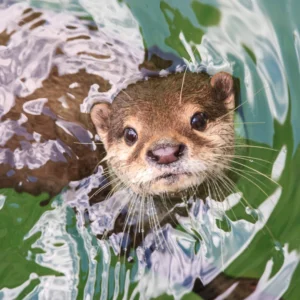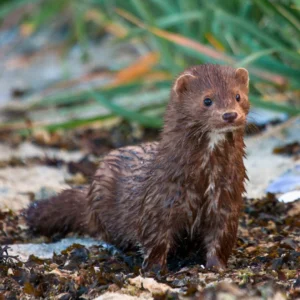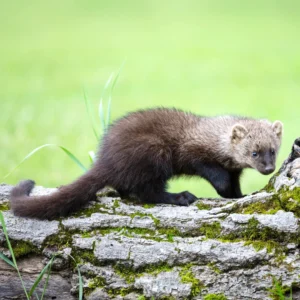Mammals of the Assabet River
August 29, 2024
OARS River Log | By Zoe Green, OARS 2024 Ecological Restoration Volunteer | Published August 29, 2024
The Sudbury, Assabet, and Concord rivers are home to many species of animals, including birds, fish, reptiles, amphibians, insects, and mammals. If you’re fortunate, you may catch a glimpse of a beaver or even a muskrat near the water’s edge. However, many of the mammals along our rivers tend to be most active during the evening and typically shy away from human contact. Among the other small river-dwelling mammals are minks, fishers, and river otters—all belonging to the weasel family. Beavers, however, known for their industrious behavior, are the least shy around humans in comparison to the elusive otter or fisher. You’ll most likely see a beaver constructing dams and lodges as their homes. To spot a beaver home (or even a beaver!), look for large stick structures in the water or along the shoreline. Beavers are also known for chewing down trees and shrubs to build their dams and lodges. Look for trees with pointed stumps or stripped bark along the water’s edge as signs of their presence. Muskrats, on the other hand, often build burrows in the river bank. Look for entrances to burrow systems near the water’s edge, typically hidden among reeds, cattails, or other aquatic vegetation. Remember to observe from a distance and avoid disturbing these creatures’ habitats. Let’s learn more about each of these creatures.
Muskrats
 |
Muskrats are medium-sized, semi-aquatic rodents, and they are one of the most common mammals found by our rivers. They have stout bodies with short legs, small ears, and a long, scaly tail that is flattened vertically. Their fur is dense and water-repellent, ranging in color from brown to reddish-brown. While muskrats’ main diet consists of aquatic plants and roots, they are not strictly herbivores and occasionally eat small animals such as fish, frogs, and insects. Muskrats are very skilled swimmers and can remain submerged for up to 15 minutes–this helps them hide from predators like hawks or owls. They are often confused with beavers due to their similar appearance in the water, but they are actually half the size and have a distinct swimming pattern of their own. |
Beavers
 |
Beavers are the largest rodents in North America, known for their stocky bodies, large, flat tails, and webbed hind feet. Like muskrats, they have dense, waterproof fur that is also brown to reddish-brown in color. They have distinct, large front teeth, known as incisors, that grow continuously throughout their lifetime and are used for chewing through wood. Beavers are most famous for their dam-building behavior. They construct dams across streams and rivers using sticks, mud, and rocks, creating ponds that provide protection from predators and give them easy access to food. Beavers are herbivores who eat primarily bark, leaves, twigs, and aquatic plants like cattails. |
Otters
 |
Although river otters are not common on the Assabet River, there have been a few winter-time sightings of them in Acton and Stow. These mysterious critters have a long, streamlined body with webbed feet suited for swimming and a sleek, dense, water-repellent coat that is dark brown on the back and lighter on the belly. Their webbed feet and strong tails lend themselves well to swimming and maneuvering underwater. They live in dens and prefer to make their home in areas by the river with dense plant cover. While they may seem shy to us, otters are skilled predators who use their sharp claws and teeth to catch fish, crayfish, amphibians, and other aquatic creatures. They might even consume small mammals, birds, and insects when available. Aside from their elusive nature and impressive hunting skills, river otters are known for their playfulness, often engaging in activities like sliding down snowbanks, playing with objects they find in their environment, and playing in groups. |
Minks
 |
With their thin, streamlined bodies and dark brown fur, minks look like smaller otters. Like otters, they are excellent swimmers and are often observed hunting for prey underwater, but unlike otters, they are solitary animals. In fact, minks are highly territorial and will mark their territory with scent markings and will defend it aggressively against intruders, especially during the breeding season. They have partially webbed feet that help them swim and sharp claws to help hunt. Minks will consume a variety of prey, including fish, crustaceans, amphibians, birds, and small mammals—even muskrats! |
Fishers
 |
Fishers are medium-sized carnivores with long, slender bodies and short legs. Although they may look like minks, they are much larger, and males can grow to be over 12 pounds. Their thick and glossy fur provides insulation in their cold forest habitats. They have dark brown coat with a lighter patch on their chest and throat. The name fisher might be misleading though, as these animals prefer to be on land, unlike their semi-aquatic counterparts. They mainly use the water to find prey and make their dens in hollow logs or burrows along stream edges. Their sharp, retractable claws are well-adapted for climbing trees. Their prey consists of muskrats, voles, rabbits, and other rodents, as well as fish, crayfish, frogs, and clams. |
While each of these mammals is listed as a species of “Least Concern” by the International Union for Conservation of Nature, they still face both natural predators and human threats. Beavers and otters are primarily preyed upon by larger carnivores such as coyotes. Minks and muskrats are often targeted by birds of prey like owls and hawks, as well as terrestrial predators such as foxes and coyotes. Occasionally, raccoons may also prey on muskrats. Fishers, being apex predators themselves, have few natural predators, and it is typically only their young that are targeted by hawks or owls. Conflicts with human activities, however, are the biggest threat to these animals. Urban development and pollution can cause the degradation of our freshwater and wetland habitats, which are essential ecosystems for these animals. Artificial dams on the river can also alter the natural flow patterns of the river, causing floods, changing animal habitats, and displacing food sources. Sustainable management of waterways is crucial to ensure the well-being of these species and their habitats for generations to come.

